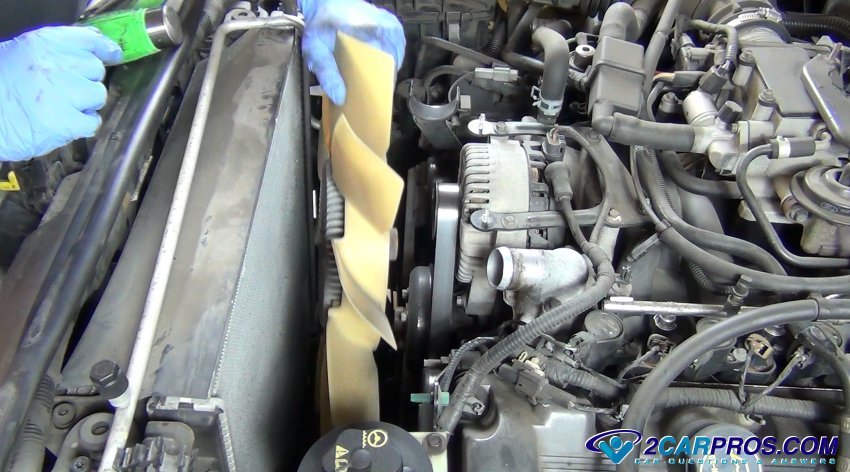The 15-Second Trick For Fan Blades
Table of ContentsThe smart Trick of Fan Blades That Nobody is DiscussingFan Blades for DummiesThe 10-Second Trick For Fan Blades
Non-thermal clutches operate solely based upon the shaft speed of the water pump. At low and idling speeds, the clutch permits the fan blade to turn at practically a 1:1 ratio. At high speeds, the silicone fluid within in the clutch will lose its capability to move the energy from the shaft to the fan clutch body (and therefore, the fan) and the fan is then enabled to practically free-wheel, removing its load from the engine.However, non-thermal clutches are a lower-cost alternative than thermal-style clutches. The thermal fan clutch operates in reaction to underhood temperatures. As hot air blows across the radiator, it heats up a thermal spring installed at the front of the clutch. As the spring is warmed, it turns and permits valve ports to open within the clutch.
This engages the clutch and drives the fan. As soon as the engine is cooled down, the thermal spring rotates back and closes the valve ports, disengaging the fan. The speed at which a thermal fan clutch spins a fan depends mostly on the specific fan you choose. On the Top Racing website, for example, you'll find 3 different types of thermal fan clutches from Hayden alone: This design turns the fan at 60-70 percent of the water pump shaft speed when engaged, and 20-30 percent when disengaged.
This fan design turns the fan at 70-90 percent of the shaft speed when engaged for increased cooling. When disengaged, it turns the fan at 25-35 percent. It's utilized with deeper-pitch fans (2Â 1/2 of pitch), and works well with higher operating rpm. Severe task thermal fans turn the fan at 80-90 percent of the shaft speed when engaged and 20-30 percent when disengaged.
This design of fan clutch operates like a thermal clutch, however the ECM/PCM signal manages the level of engagement of the EV clutch. This engagement procedure is ultimately managed through the ECM/PCM by the following input variables: Coolant Temperature, Consumption Manifold Temperature, Transmission Oil Temperature Level, A/C Pressure and Engine Oil Temperature.
Like all components, fan clutches will wear and require changed. fan blades. According to Hayden, here are some signs your fan clutch might require replaced: Fan spins excessively when engine is stopped (three or more times when hot engine is shut down). Poor A/C performance at idle or low automobile speeds.
An Unbiased View of Fan Blades

Fan speed does not increase up until engine is exceedingly hot. Fan blade tip moves more than 1/4-inch front to back. Fan turns roughly or does not turn at all. Extreme fan sound at all speeds due to failed bearing. Vibration that increases with engine speed. Leaking fluid or oily develop around the bearing or thermal spring.
289, 302, W/ FAN CLUTCH BOSS 302, W/ FAN CLUTCH 250, W/ FAN CLUTCH W/ FAN CLUTCH, REPLACEMENT 289, FACTORY A/C AND FAN CLUTCH 289, DELUXE DEALER A/C 200, FACTORY A/C, POWER FAN, W/O EMISSIONS FAIRLANE, TORINO, 200, A/C, POWER FAN, W/ EMISSIONS: This product can expose you to chemicals including lead and DEHP, which are known to the State of California to cause cancer and birth problems or other reproductive damage.

Almost unprecedented on modern cars and trucks with electric engine cooling fans, individuals often still refer to the accessory drive belts as "fan belts." This term harkens to the day when cars and trucks utilized drive belts to drive the cooling fan or water pump. browse this site The engine cooling fan, made of plastic or metal, isn't hard-connected to the fan pulley-block or water pump, but instead is soft-connected through the fan clutch.
A failing fan clutch might leave you stranded with expensive repair work costs, so focus on these symptoms. Here, you can see where the fan and fan clutch are driven by the engine (fan blades). Morio/ Wikimedia Commons There are three kinds of fan clutch, depending upon the car's design. A small amount of resistance constantly keeps the fan spinning, however it's essentially free-wheeling until the fan clutch engages.

Not known Details About Fan Blades
A centrifugal valve opens to permit the circulation of heavy silicone fluid, locking the fan blades to the sheave. At idle and low engine speeds, this fan clutch is completely engaged, gradually disengaging as engine speed boosts. Depending on the application, it might freewheel above 2,500 to 3,000 rpm. An functions similar to thermal and torque-limiting types however isn't modulated directly by temperature or speed.
If the fan clutch is going bad or has stopped working, there are a number of ways you might observe. Taking note of your car is the initial step in a precise diagnosis, efficient repair work, and trusted vehicle. at low speed blog here or when stopped is the most-common fan clutch failure sign.
At a stop, though, due to the fact that the fan clutch does not engage and air isn't forced through the radiator, the engine can't dissipate excess heat. in winter season is another typical issue but triggered by the opposite fan clutch his explanation failure. If the fan clutch takes, it stays engaged all the time, cooling down the engine too much.
This can cause bearing damage, radiator damage if the blades flex too far, or even shatter a plastic fan. after engine shut-down may show a weak clutch. Silicone fluid dripping from the fan clutch would trigger this issue. When the engine is off, there are a couple of things you can do to inspect the fan clutch:. fan blades.